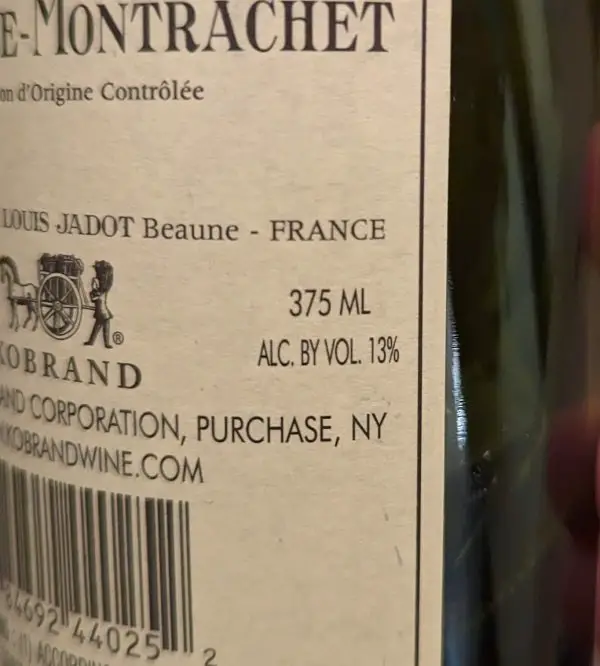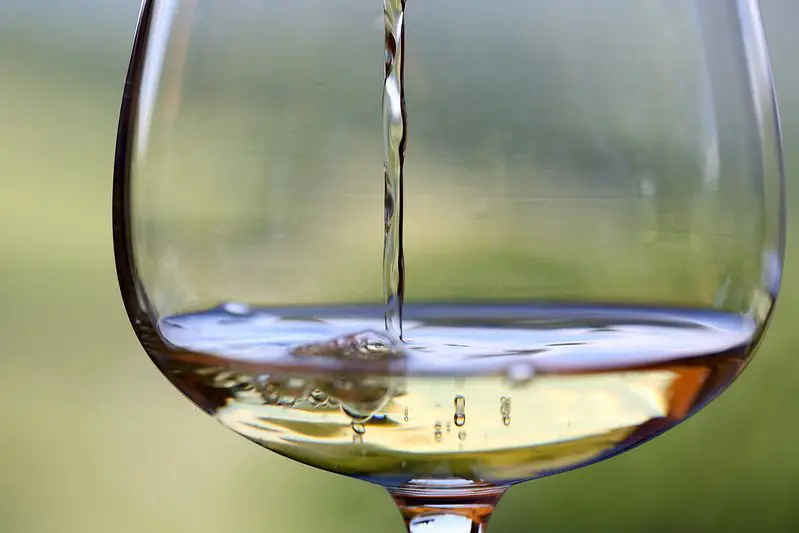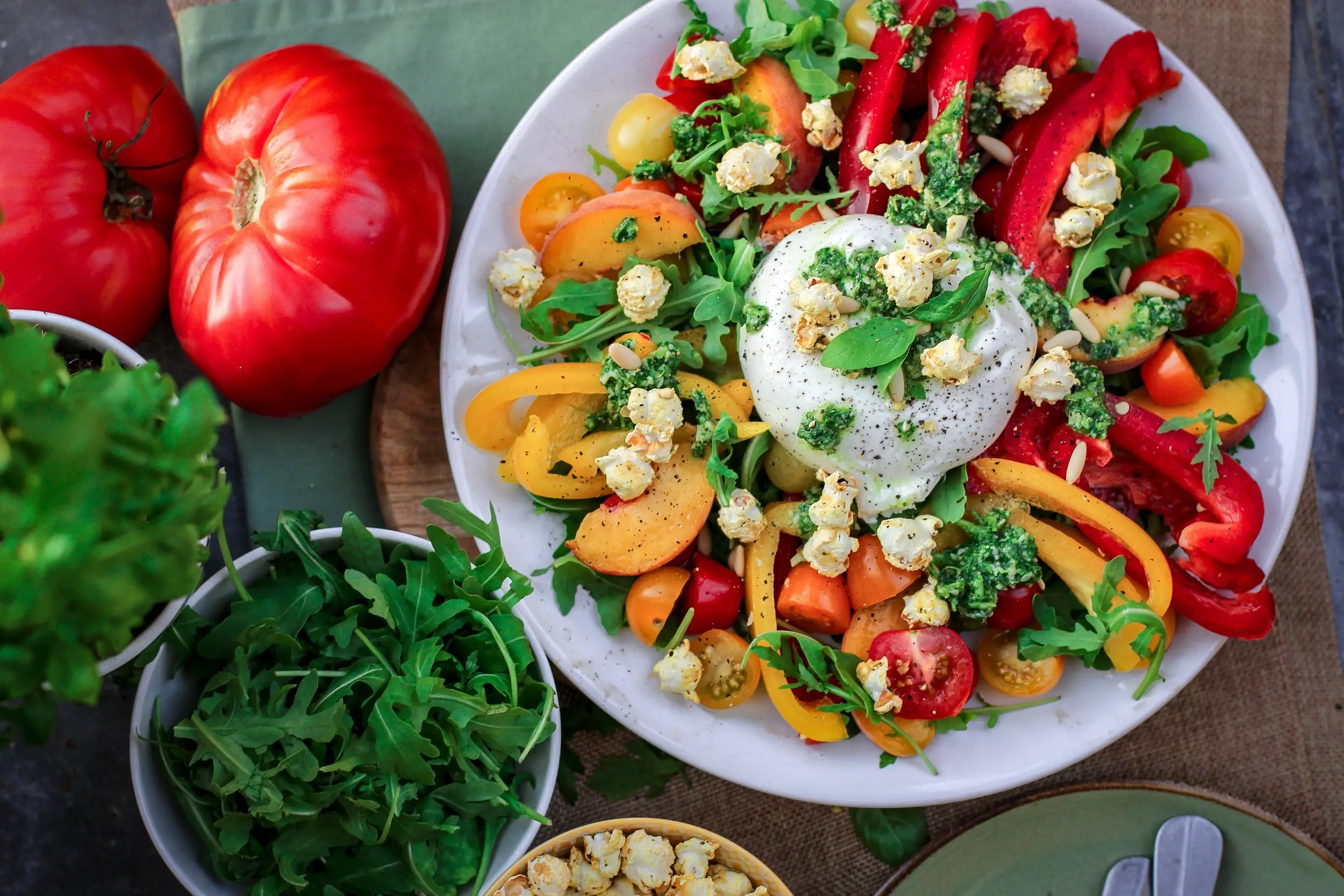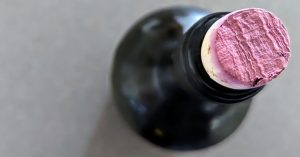
At some point on your wine journey, you’ll be faced with a choice: Chardonnay or Pinot Grigio. Oh! Such problems!
Chardonnay and Pinot Grigio both make dry white wines, but Chardonnay is richer, and has a fuller body, feeling heavier in your mouth. Chardonnay can have citrus, tree, stone, and tropical notes, and sometimes butter and toast. Pinot Grigio tends to have higher acid with green and yellow tree fruit and stone fruits.
Here’s what you need to know about the differences between Chardonnay and Pinot Grigio.
- Where Is Chardonnay From?
- Where Is Pinot Grigio From?
- Chardonnay Wine Flavors
- Pinot Grigio Wine Flavors
- What’s the Difference Between Chardonnay and Pinot Grigio?
- Is Chardonnay Sweeter than Pinot Grigio?
- Differences in Appearance Between Chardonnay and Pinot Grigio
- Differences in Aging Potential Between Chardonnay and Pinot Grigio
- Which Is More Expensive: Chardonnay vs Pinot Grigio
- What’s the Serving Temperature for Chardonnay and Pinot Grigio?
- What Has More alcohol? Pinot Grigio or Chardonnay?
- Which Is better for Cooking: Chardonnay or Pinot Grigio
- Chardonnay Food Pairing Ideas
- Pinot Grigio Food Pairing Ideas
- Final Thoughts: Chardonnay vs Pinot Grigio – Classic or Easy-going?
- Thirsty for More?

Where Is Chardonnay From?
Chardonnay is from the Burgundy region of France. Chardonnay enjoys tremendous popularity and today you’ll find Chardonnays made around the world, from France to California, to Australia, and everywhere in between.
Fun Wine Fact: Chardonnay from Burgundy is called White Burgundy. The label might not even have the word “Chardonnay” on it. The producer just assumes you know it’s Chardonnay. Not super helpful for new wine drinkers. Red Burgundy is always Pinot Noir.
Chardonnay adapts to the local environment and does well in both warm and cool growing conditions. (Here’s a full link to Chardonnay wines.) Knowing where your Chardonnay is from will help you pick a wine that you like! Keep reading to find out how.
Fun Wine Fact: Chardonnay is the most popular white wine in the US.
Where Is Pinot Grigio From?
Pinot Grigio comes from the Piemonte area of northwestern Italy, but today is closely associated with the Veneto region in northeastern Italy (this is what the map’s shows) where it’s by far the most widely-grown grape mainly produced in huge volumes by massive cooperatives.
Like Chardonnay, Pinot Grigio has found its way to winegrowing regions around the world, and enjoys tremendous popularity with wine lovers. (Here’s a full link to Pinot Grigio wines.)
Famous Pinot Grigio regions outside of Itlay include Alsace, France, and Oregon.
Fun Wine Fact: Pinot Grigio goes by Pinot Gris in other parts of the world (like Alsace), but they’re the same grape if you see either name on a bottle of wine.
Chardonnay Wine Flavors

- Lemon
- Green or Yellow Apple
- Nectarine
- Peach
- Pineapple
- Toast
- Caramel
- Vanilla
- Butter
Helpful Tip: Here’s a 30-second tasting tip to help you identify the fruits and floral notes you’re smelling in white wine.
Winemakers often use oak to age Chardonnay to give the wine toast, caramel, and vanilla notes. They also will put the wine through a process called malolactic fermentation – or malolactic conversion – to soften the wine and give it buttery notes and more mouthfeel.
Helpful Tip: If you’re curious about malolactic fermentation, I put together this slightly nerdy post: Why does my wine taste like butter? It’s not for everyone, but maybe it’s for you!
Chardonnay finds itself planted in a diverse range of growing climates, from cool to hot. Chardonnay reflects the growing conditions in its flavor profile.
Cool climate Chardonnay has more citrus, like lemon, lime, and grapefruit, as well as green apples and underripe stone fruits, like white nectarine and peach. Cool climate Chardonnays include:
- Chablis
- Niagra Peninsula
- Petaluma Gap
- Santa Ynez Valley
- Yarra Valley
- Carneros
Warmer climate Chardonnay has ripe, tropical fruit, like pineapple, mango, or even peach jam and lemon curd. Warmer climate Chardonnays include:
- Napa Valley
- California’s Central Valley
- Chile’s Central Valley
Helpful Winebuying Tip: When you’re shopping for a Chardonnay, read the label carefully – look for flavors that point to a cooler or warmer growing climate depending on the Chardonnay wine style you like.
Pinot Grigio Wine Flavors

- Green or Yellow Apple
- Lime
- Lemon
- Green or Yellow Pear
- White Peach
- Nectarine
- Honey
- White Blossom
- Chalk
- Green Almond
Pinot Grigio’s known as a light, semi-aromatic white wine. Pinot Grigio is almost always made in a dry, unoaked style. The typical Pinot Grigio is made to appeal to the mass market, meaning it’s friendly, easy to drink, and uncomplicated.
Don’t be fooled. You can (and will) find producers playing with Pinot Grigio to craft surprising wines.
Personally, I’m always surprised by Pinot Grigios where the winemaker decided to have some fun – and I’m always tricked by it on blind tastings. Sneaky Pinot Grigio.
Here are a few ways that they manipulate Pinot Grigio:
- Fermenting with Partial Skin Contact – Most white wines don’t have any skin contact during fermentation. The winemaker presses off the grape juice and starts the fermentation process to keep the fruit pure. Fermenting with skin contact gives the wine a little tannin and even a golden color.
- Fermenting in Barrel – Most Pinot Grigios are made using stainless steel, again to keep the purity of the fruit. Fermenting in the barrel gives the wine texture and grippyness that you’ll feel in the back of your mouth.
- Extending Lees Contact – Lees are dead yeast cells left over from fermentation. When a white wine is left in contact with these lees, they begin to break down and can give the wine toasty, brioche notes and also a creaminess and more body in your mouth.
All of these practices are uncommon with Pinot Grigio, and you won’t find any of these qualities in an inexpensive, mass-produced wine.
BUT – these nifty qualities that showcase winemaking craft tend to show up in wines made by small boutique producers and in higher-qualtiy wines, so don’t be surprised if you discover something curious in your glass of Pinot Grigio!
What’s the Difference Between Chardonnay and Pinot Grigio?
Chardonnay makes classic rich, creamy, full-bodied white wines with warmth and depth of spice, toast, and butter. Pinot Grigio’s style is light and bright, with soft fresh fruits that slip through your mouth.
A common misconception is that Chardonnay always makes full-bodied rich white wines. Chardonnays can also be made into lean, austere, high-acid or even delicate dry white wines. This style of Chardonnay is actually more similar to Pinot Grigio.
Helpful Winebuying Tip: If you want a lean, acidic Chardonnay, shop for a Chablis from France. Chablis is always 100% Chardonnay made in a fruit-forward style without oak. (This would actually be a super-fun and interesting side-by-side tasting experiment with a Pinot Grigio.)
Is Chardonnay Sweeter than Pinot Grigio?
Chardonnay and Pinot Grigio are both almost always made into dry white wines. However, some Pinot Grigio wines may have a little residual sugar (sweetness) added to them if they’re made for the mass market.
This is one reason why Pinot Grigio is so popular.
It’s worth noting that sweetness can vary depending on the specific winemaking techniques used, or even the region where the grapes are grown.
Fun Wine Fact: Some winemaking processes can impart the impression of sweetness. For example, if your Chardonnay was aged in toasted oak barrels, it may smell like caramel and toffee. This can trick your brain into thinking your Chardonnay is sweet, even if it’s 100% dry!
Helpful Tip: Here’s a full rundown of sweetness in wine that’s useful if you’re trying to figure out if you’re wine’s sweet (or not).
Differences in Appearance Between Chardonnay and Pinot Grigio
Chardonnay and Pinot Grigio wines will both be pale lemon and look similar in your glass. Chardonnay can have a more golden or deeper hue than Pinot Grigio if it was aged in oak. Pinot Grigio might have the slightest tinge of pink. This is because Pinot Grigio grapes are actually a greenish-grayish-pinkish color.
Who knew? Now YOU do!
Differences in Aging Potential Between Chardonnay and Pinot Grigio
Chardonnay has more potential to age than Pinot Grigio because it has more fruit intensity. Over time, fruit flavors fade in wine. Pinot Grigio doesn’t have the same concentration of fruit flavors and aromas that can allow it to age. Keep in mind that inexpensive or entry-level Chardonnay and Pinot Grigio wines aren’t made to age and you should drink these as soon as you buy them.
Which Is More Expensive: Chardonnay vs Pinot Grigio
Pinot Grigio is less expensive than Chardonnay thanks to fewer winemaking costs, like aging in oak barrels. A 90+ point Chardonnay from Burgundy, France, starts at around $35 USD and a 90+ point Pinot Gris from Alsace, France starts at around $30 USD. But you can find beautiful 90+ Chardonnays and Pinot Grigios from other regions of the world for under $20 USD.
Chardonnay and Pinot Grigio enjoy tremendous popularity and are made at all price points, from extreme value to ultra-premium.
Pinot Grigio doesn’t command the ultra-premium price of Chardonnay.
You can find Chardonnays that sell for hundreds, if not thousands of dollars.
But even the most expensive Pinot Grigios won’t break the $100 USD price point. As a grape, Pinot Grigio doesn’t have the intensity of flavor to make age-worthy and investment-worthy wines.
What’s the Serving Temperature for Chardonnay and Pinot Grigio?

Both Chardonnay and Pinot Grigio are served chilled, but Pinot Grigio is generally served at a lower temperature than Chardonnay.
Put both wines in your refrigerator the day before you drink them (at least 3 hours before you open the bottle).
- If you’re drinking Chardonnay, take the bottle out 10-15 minutes before pouring.
- If you’re drinking Pinot Grigio, take the bottle out, pour yourself a glass, and enjoy immediately.
- If either wine seems closed (not very aromatic), give it a good swirl and let it warm up for 5-10 minutes.
Helpful Tip: To chill or not to chill? This is always a wine question – so I put together this post that goes over what wines to chill and for how long that anyone can use!
What Has More alcohol? Pinot Grigio or Chardonnay?

Almost all Pinot Grigio and Chardonnay dry white table wines will have medium alcohol of 12%-14% ABV, but Pinot Grigio tends to be around 12% alcohol by volume. Chardonnay often has alcohol between 12.5%-13.5% ABV.
The level of alcohol in Pinot Grigio or Chardonnay is directly related to the growing climate. Warmer regions mean riper grapes and more sugar accumulation that can be fermented into alcohol (higher alcohol wines).
If you’re concerned about alcohol content, then choose wines that are from cooler growing regions.
Helpful Wine Shopping Tip: Hotter growing climates help grapes accumulate more sugar. More sugar means more alcohol. Higher alcohol wines have more body. So, a high-alcohol Chardonnay (14.6% ABV), will be heavier than a lower-alcohol Pinot Grigio (12% ABV). Reading wine labels can help you pick out the wine style you want: heavier or lighter?
Which Is better for Cooking: Chardonnay or Pinot Grigio
Both are interchangeable for cooking. Both Chardonnay and Pinot Grigio are widely available and made at all price points. So, it comes down to which wine you want to cook with and drink (because you know you’ll be pouring yourself a glass – who doesn’t?).
Choose the wine you’ll enjoy the most.
Chardonnay Food Pairing Ideas

Chardonnay’s classic rich and creamy body lends itself to dishes with more weight, though it works with the same foods as Pinot Grigio, too. Think earthy, umami flavors. Here are some ideas to get you started:
- Spaghetti Carbonara
- Beef Stroganoff
- Lentil Soup
- Roasted Carrot Soup
- Grilled Portabello Mushrooms
Side Note: Chardonnay’s a personal favorite. I drink it regularly with great indulgence. Here are my 5-go-to weekday Chardonnay pairings. Here’s a guide to Chardonnay and cheese pairing ideas.
Pinot Grigio Food Pairing Ideas

Pinot Grigio’s light, easy drinking style makes it a go-to wine for dishes that showcase fresh vegetables. Think about pairing Pinot Grigio with foods that call for a dash of vinegar or lemon zest.
- Vegetable trays
- White fish
- Shrimp
- Green Salads
- Noodle Salads
- Anything with a vinaigrette
- Herbed white meats
But Pinot Grigio’s also delicious just on its own as a sipping wine.
Final Thoughts: Chardonnay vs Pinot Grigio – Classic or Easy-going?
If you’re into classic, rich, creamy white wines with warmth and body, then Chardonnay is a better wine for you. Pinot Grigio will bring you a lighter white wine drinking experience with citrus and stone fruit. If you enjoy white wines that are easy to drink socially or with your summer salads, then pick up a bottle of Pinot Grigio.
A great way to get started with these two wines is by doing a side-by-side comparison.
Pick up two bottles of similarly-priced wines: 1 bottle of Chardonnay and 1 bottle of Pinot Grigio. Pour yourself a glass of each, side-by-side, and taste them slowly.
- Can you smell the difference in the power of the aromas? (Pinot Grigio will be more aromatic unless the Chardonnay used oak, then you may smell spice on the Chardonnay that you can smell in the Pinot Grigio).
- Can you feel the difference in the wine’s body? (Chardonnay should feel heavier on your tongue compared to Pinot Grigio)
- Can you distinguish the different fruit flavors?
A side-by-side comparison is the best way to understand the differences between these two beloved wine grapes – and you get to drink wine, so what’s not to like about a little experimentation?
Discover More:
Sauvignon Blanc v Pinot Grigio
Pinot Grigio vs Pinot Blanc
Cabernet Sauvignon vs Chardonnay
Merlot vs Chardonnay
Chenin Blanc vs Chardonnay
Thirsty for More?
Doing side-by-side tastings, or wine flights, are a fabulous way to learn about wine. So, I wrote a post on wine flights, and what they are, and include 16 ideas for your next wine flight. Go check out wine flights here.
Once you’ve opened up your 2 bottles of wine, you’re most likely going to have leftovers (if you don’t, I’m not judging!). I wrote this post on refrigerating wine and what you need to know about keeping leftover wine fresh for as long as possible. Go check it out!



